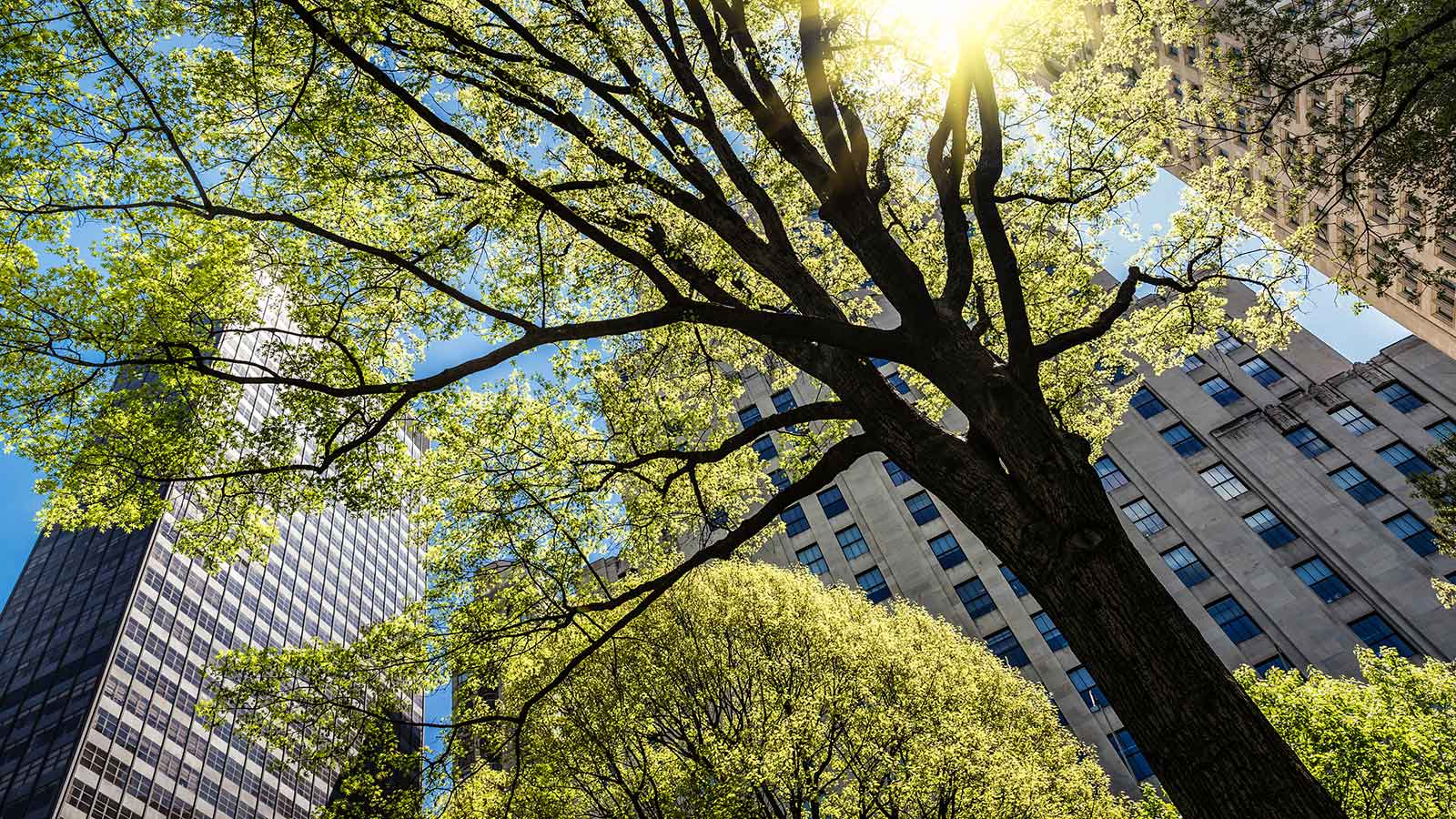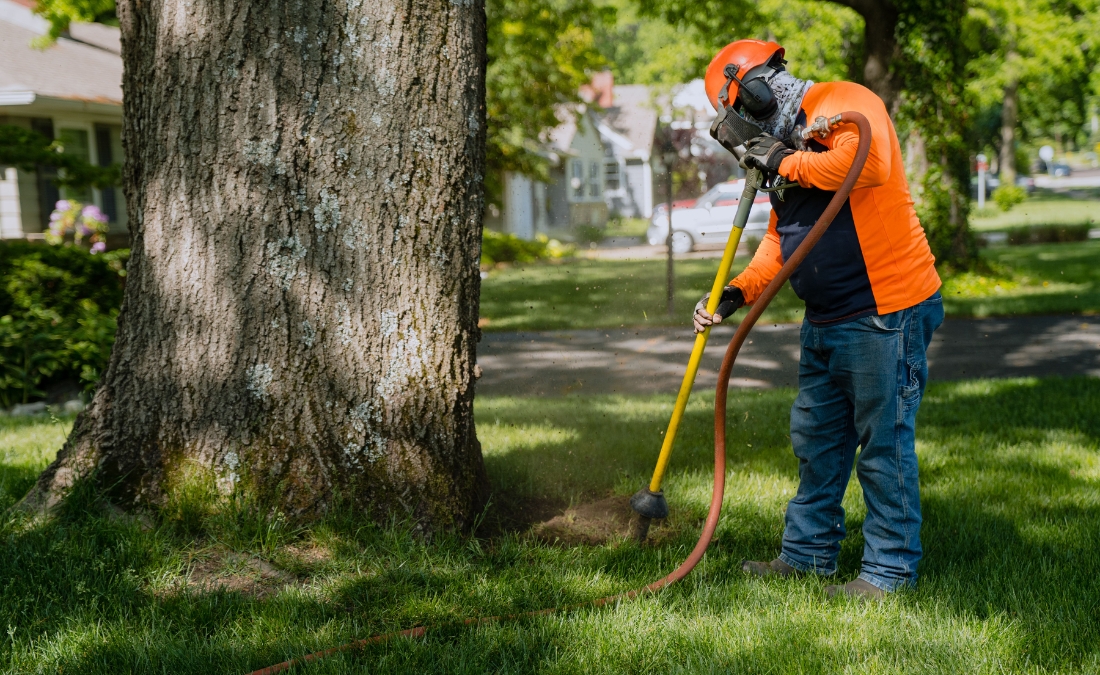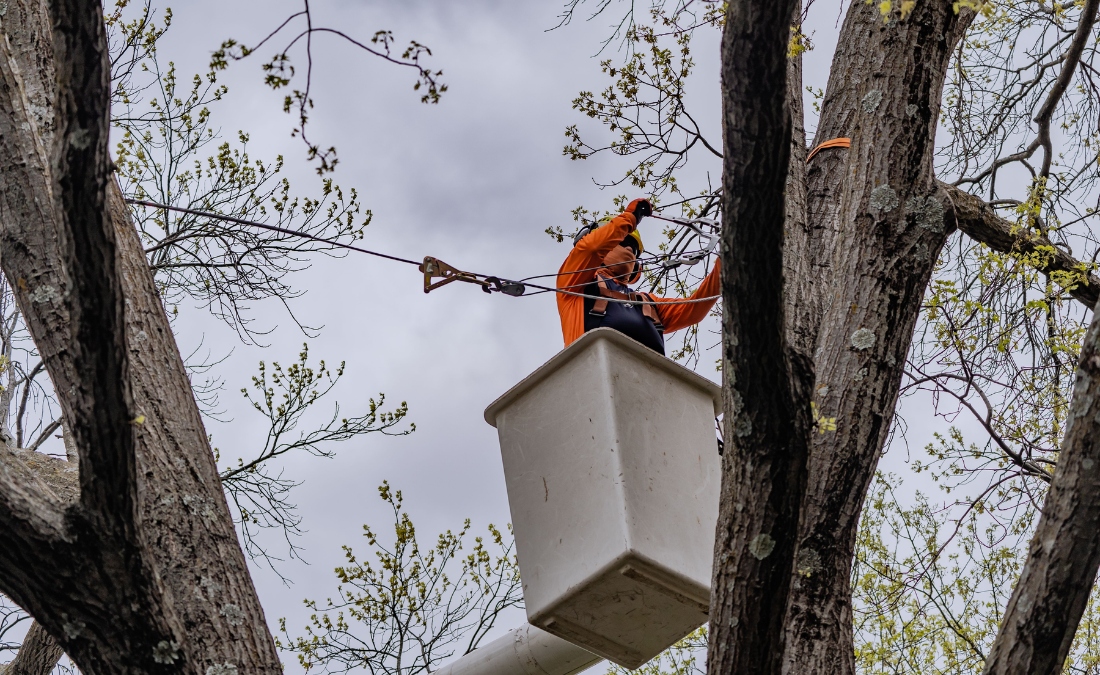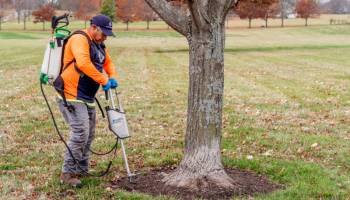The Danger of Heat Stress and How to Protect Your Midwest Trees

Midwest heat waves can do more than dry out lawns – they can also weaken or kill trees. Learn how to spot heat stress and protect your property this summer.
Midwest summers are heating up – and fast. In 2024, the U.S. saw its hottest year on record, with temperatures breaking records across the map. That kind of extreme heat doesn’t just wear us down; it puts serious strain on the shade trees working hardest to keep our yards cool. And when trees can’t keep up with the heat, stress starts to show in ways that are easy to miss – until it’s too late.
Key Takeaways
- Heat stress occurs when temperatures exceed a tree’s normal tolerance range (typically above 90 degrees), causing symptoms like wilting leaves, brown discoloration, stunted growth, and bark cracks.
- Trees in urban areas like Kansas City or Fort Worth are especially vulnerable due to the urban heat island effect, where temperatures in cities are higher than in rural areas.
- Deep watering with about 10 gallons per inch of trunk diameter using soaker hoses or irrigation systems is the most essential protection method, ideally done early in the morning.
- Proper mulching (2-4 inches deep around the drip line) helps conserve moisture and keep roots cool.
- Heat stress can be fatal to trees (with mortality rates up to 79% in some studies) and makes them more susceptible to pests and diseases.
How Heat Stress Impacts Tree Health
Heat stress occurs when temperatures rise above what a tree can normally handle. This can cause the tree to experience several adverse effects, including leaf loss, reduced growth, and decreased vigor – and in extreme cases, heat stress can kill a tree.
Urban trees, like those in Kansas City or Forth Worth, are especially vulnerable. Citities often experience what’s known as the urban heat island effect, where pavement and buildings absorb heat and raise local temperatures. This extra heat puts added pressure on nearby trees, making heat stress even more likely.
Under normal circumstances, trees perform a process called transpiration. It involves the tree drawing water up from the roots to the leaves and evaporating it from the leaves’ stomata (tiny pores). In some circumstances, trees can lose over 100 gallons of water a day from transpiration.
What’s even more concerning is when transpiration does not occur. During extreme temperatures, trees will close their stomata and stop transpiring. This causes the tree to shut down, and it won’t draw fresh nutrients and water from the soil. If the conditions persist, this lack of nutrients and water can have detrimental effects on a tree.
The Signs of Heat Stress in Midwest Trees
When you notice the temperatures are hotter than usual, it should serve as a sign to examine your trees for symptoms of heat stress. Some typical symptoms that may indicate heat stress include:
- Wilting leaves
- Drooping branches
- Brown or discolored leaves
- Stunted growth or small leaves
- Cracks in the bark in extreme situations
How to Protect Your Trees from Heat Stress
While heat stress may sound bad, there are things you can do to mitigate its effects on your trees. Even if you can’t change the weather, knowing what to do and not to do can help you steer your tree through the worst effects of heat.

1. Water Your Trees the Right Way
One of the best things you can do for your trees during hot, dry weather is to provide supplemental water. Use a low and slow approach, ideally with a soaker hose or irrigation system. This allows water to soak deep into the soil, encouraging strong root growth and minimizing waste. A good rule of thumb is to apply about 10 gallons of water for every inch of the tree’s trunk diameter.
Focus your watering around the tree’s drip line – the area directly beneath the outer edge of the canopy. And whenever possible, water early in the morning, when cooler temperatures reduce evaporation.
Not sure if your tree needs water? Try the screwdriver test: push a long screwdriver into the soil. If it comes out cool and moist, the tree is good. Or just dig a few inches down and feel the soil with your hand.
Keep in mind: if the weather is extremely hot and the tree shuts down its transpiration process (by closing its stomata), it won’t be able to take in much water. That’s why it’s important to water before and after a heatwave, when the tree is still actively drawing in moisture.

2. Mulch Your Trees
Mulching around the tree’s base can help conserve moisture and keep roots cool.
Mulching is essential for tree health all year round, but it can be especially beneficial during summer. Mulch helps keep roots cool and moist, which is critical for preventing heat stress. It also helps to prevent water loss from evaporation, meaning that your tree will require less watering.
There are a variety of different mulches you can use, including wood chips, bark, straw, and compost. Apply a layer of mulch 2-4 inches deep around the tree’s drip line. Be sure to avoid putting any mulch directly against the tree trunk, as this can cause rot.
3. Avoid Tree Pruning in the Summer
While tree pruning has many benefits for your trees, it’s something to avoid in the summer when temperatures are hottest. Pruning can increase the amount of leaf surface area exposed to the sun, exacerbating heat stress. Put away your pruning tools during summer and save them for winter, when pruning has many benefits.
Some species are particularly vulnerable to summer pruning. Avoid pruning maples when the temperature is extremely hot, as it can cause health issues. Pruning oaks in the summer is also not advisable, as it can open them up to a deadly disease called oak wilt. Pruning wounds on your oaks will attract oak bark beetles, which can transmit the disease to the tree and likely kill it.
4. Plant the Right Trees
Sometimes the best thing you can do for your trees is to plant the right ones in the first place. Different species of trees have different tolerances of heat and drought. Planting a tree that can survive the heat will limit the worst effects of a heat wave.
Some trees we recommend considering planting include:
- Live oaks
- Crape myrtle
- Bald cypress
- White oak
- River birch
Before planting a tree, consider discussing it with an arborist about the species you plan to plant and see if they believe it’s the right choice for your property. Arborists have a saying, “the right tree in the right place.” And this statement is even more true when it comes to picking a tree that can survive in the heat of your area.
The Long-Term Danger of Heat Stress for Midwest Trees
Heat stress can cause tree death. In fact, extreme heat is one of the leading causes of tree mortality worldwide. One study of 20 different conifer species found that the mortality rates reached as high as 79% under prolonged hot and dry conditions.
Even if heat doesn’t directly kill a tree, the stress can lead to additional problems. Pests and diseases target stressed trees and can increase the damage to your tree. Additionally, heat-stressed trees produce less fruit and seed, which can impact wildlife that rely on them for food.
Frequently Asked Questions About Heat Stress in Trees
Heat stress is highly harmful to trees, but the heat’s effect on trees isn’t likely the first thing many think of when the temperature rises. To help you understand the threat it poses to your trees, we’ve answered some common questions homeowners have about heat and drought stress in trees.
What temperature is too hot for most trees?
While every species is different, the best growing conditions for most trees range from 70 to 85 degrees. Once the temperature reaches above 90 degrees, trees will struggle to perform photosynthesis and begin to feel the heat stress.
Should I provide fertilizer when my trees are dealing with heat stress?
We recommend avoiding fertilization in the summer when trees suffer from heat or drought stress. Fertilization can encourage too much new growth that will increase stress on your tree and force it to use its energy for growing rather than dealing with the heat. Instead, wait until the fall to perform fertilization.
Are young or mature trees more likely to have problems with heat and drought stress?
While you may think young trees are less susceptible to heat stress due to needing less water, they are actually more at risk of dying from the heat. Young trees do not have the same expansive roots and water reserves as mature trees. Always give them extra attention when the Midwest weather is hot and dry.

Protect Your Trees from the Heat – Get Expert Help from Arbor Masters
If the heat is starting to wear you out, imagine what it’s doing to your trees. Extended high temperatures can put even healthy trees into decline if you’re not paying attention. If something seems off and you want to stay ahead of a serious problem, the team at Arbor Masters is ready to help.
One of our qualified arborists can inspect your trees and determine how extensive the damage is. Then, we’ll help you create a personalized care plan to help it survive the summer. Call us today at 913-441-8888 or request a quote online.

Get the latest local news, tree care tips, special offers, and company updates directly to your inbox! It's easy to subscribe and there's no spam - we promise.
"*" indicates required fields





